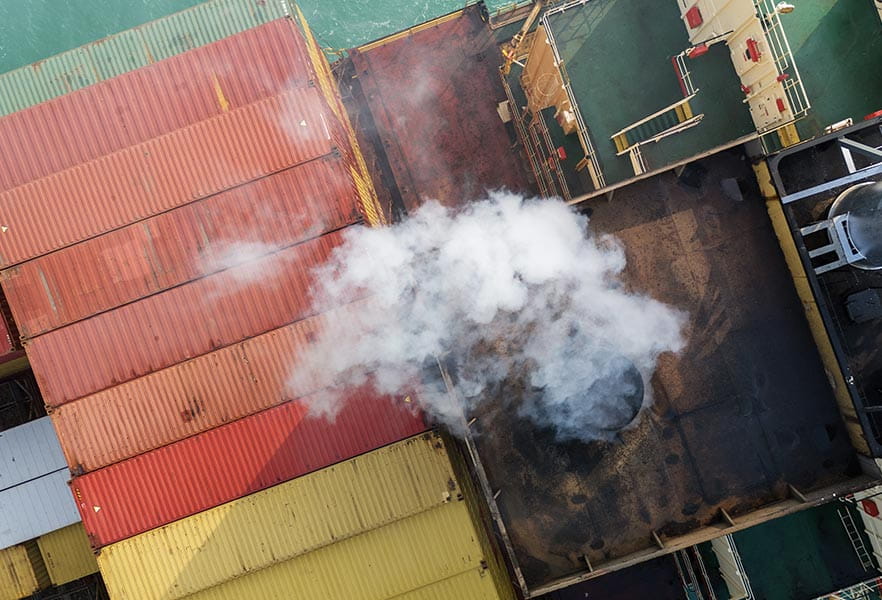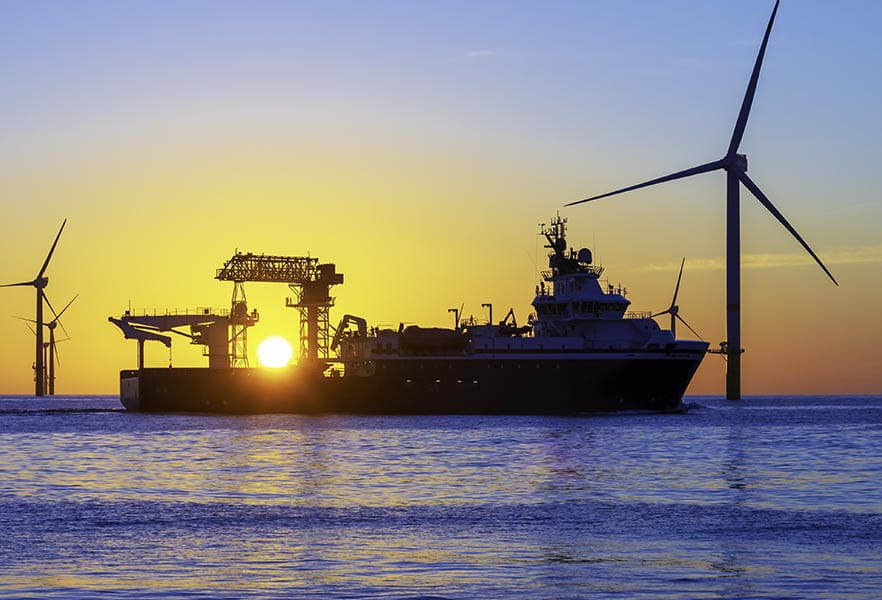Read more about the 16th IRENA Assembly
High seas, higher stakes: shipping’s path to a greener future

We might not see it every day, but shipping plays a vital role in our daily lives.
Container ships transport 90% of global goods, from the toothbrush you used to clean your teeth this morning to the device you’re reading this on. They bring us food from across the world and enable fuel-importing countries to keep their lights on.
But these vast vessels are carbon-intensive, responsible for around 3% of global emissions – and it will require a titanic effort to bring them in line with Paris Agreement targets.

The industry itself is responding to the challenge. The International Maritime Organization has set an ambitious (albeit not legally binding) target to reduce its emissions by 70% by 2030. And it’s even proposing an unprecedented global emissions tax to help it achieve this goal.
How feasible are these aims and what technologies are being developed to achieve them?
A unique challenge
Shipping is a “hard-to-abate” sector, posing more challenges than most to decarbonize.
The most obvious is logistical. The sheer size of container ships and the length of their voyages across the oceans mean they need a fuel source that generates the maximum amount of energy per kilogram. While promising alternatives to fossil fuels like hydrogen and biofuels are being developed, these relatively young technologies are yet to be deployed on a large scale.
Shipping underpins so many international supply chains that disruptions can have global economic ramifications. Replacing older carbon-intensive vessels with fleets of cleaner, next-generation ships is a massive investment for shipping companies to take on – some $1.4 trillion. Passing on those costs could cause price spikes further along the supply chain, something both shippers and their customers are anxious to avoid. Ultimately, this limits the pace of change in the industry.
Ambitious legislation is critical to overcome these significant obstacles. But setting and enforcing coherent regulations in an industry spread across hundreds of national jurisdictions as well as international waters is a challenge in its own right.
Ambitious regulation
From the IMO to the GCC, international bodies are already starting to put such regulations in place. Measures must be ambitious enough to meet climate targets and smart enough to do so in a way that allows the industry to remain afloat.

Last year, the EU announced landmark FuelEU regulations, mandating the maritime sector to cut greenhouse gas (GHG) emissions by 2% from 2025 and increasing incrementally to 31% by 2040 and 80% by 2050. It applies to all ships that come and go from European ports. Although clearly an important first step, some have pointed out that these targets are still not in line with the 1.5ºC temperature goal of the Paris Agreement.
The IMO took this one step further. It’s committed to a 70% GHG reduction for global shipping by 2040. “While this revised strategy is not legally binding, the measures used to implement it can be,” as the International Council on Clean Transportation points outv.
One of the standout measures posed by the IMO is a global GHG fee imposed on ships for every ton of CO2 they emit. It would incentivize the uptake of zero- and low-carbon fuels like green ammonia, hydrogen and methanol – as well as technologies such as on-board carbon capture – by narrowing the price gap with fossil fuels. At the same time, it would create a pot of money worth around $2.5 billion per year that could, in theory, be invested in sustainable maritime projects in developing countries.
The questions of how far this levy will go or how it will be enforced remain open, with precise details still to be thrashed out in ongoing talks between IMO member states. Nevertheless, if it goes through, it would be an unprecedented step and an example for other industries to follow. As a legally binding and universal measure, it would make effective implementation more likely and would have the lowest impact on the global economy.
Innovation on the waves
Measures like this provide a direct boost to innovators around the world pioneering sustainable alternative fuel sources.
“Drop-in” biofuels are the most well-known and widely used today, compatible with current engines and capable of producing up to 90% fewer carbon emissions per unit of energy than conventional diesel. They are the most cost-competitive alternative today, but there are question marks over their long-term scalability.
Green hydrogen is the most promising option to replace fossil fuels in the long term. Hydrogen fuel cells can be retrofitted to ships relatively easily, and without needing to significantly alter current routes. The first hydrogen-powered cargo ships are already being built, and hydrogen production is ramping up. Here in the Middle East, Masdar is set to build new facilities in Egypt, targeting a 4GW capacity by 2030 and an output of 480,000 tons of green hydrogen per year. It has also recently entered into a long-term partnership with logistics giant CMA CGM Group to supply ships with clean alternative fuels.
Ammonia is another promising option. With 10 times the energy density of a lithium-ion battery, and also capable of vast emissions reductions, it’s perfectly suited for heavy ocean-crossing container ships. The world’s first ammonia-powered vessel will set sail by the end of 2024, but there is likely to be a lag time before the infrastructure required to produce this fuel at scale is more developed.

Shipping is the bedrock of the modern global economy. Decarbonizing it is one of the most complex challenges for humanity to overcome in pursuit of a net-zero world.
The IMO’s new GHG reduction targets are just the first step. Formalizing the regulations to make those targets a reality is the second, laying the groundwork for clean alternative fuels to emerge at competitive prices.
But by far the most difficult step is still to come: innovation and investment on a global scale to equip fleets for the future. The speed with which we can move through these steps will help determine the effectiveness of our response to the climate crisis.
But if we can decarbonize this most complex of industries, a sustainable future will be firmly in our sights.
Container ships transport 90% of global goods, from the toothbrush you used to clean your teeth this morning to the device you’re reading this on. They bring us food from across the world and enable fuel-importing countries to keep their lights on.
But these vast vessels are carbon-intensive, responsible for around 3% of global emissions – and it will require a titanic effort to bring them in line with Paris Agreement targets.

The industry itself is responding to the challenge. The International Maritime Organization has set an ambitious (albeit not legally binding) target to reduce its emissions by 70% by 2030. And it’s even proposing an unprecedented global emissions tax to help it achieve this goal.
How feasible are these aims and what technologies are being developed to achieve them?
A unique challenge
Shipping is a “hard-to-abate” sector, posing more challenges than most to decarbonize.
The most obvious is logistical. The sheer size of container ships and the length of their voyages across the oceans mean they need a fuel source that generates the maximum amount of energy per kilogram. While promising alternatives to fossil fuels like hydrogen and biofuels are being developed, these relatively young technologies are yet to be deployed on a large scale.
Shipping underpins so many international supply chains that disruptions can have global economic ramifications. Replacing older carbon-intensive vessels with fleets of cleaner, next-generation ships is a massive investment for shipping companies to take on – some $1.4 trillion. Passing on those costs could cause price spikes further along the supply chain, something both shippers and their customers are anxious to avoid. Ultimately, this limits the pace of change in the industry.
Ambitious legislation is critical to overcome these significant obstacles. But setting and enforcing coherent regulations in an industry spread across hundreds of national jurisdictions as well as international waters is a challenge in its own right.
Ambitious regulation
From the IMO to the GCC, international bodies are already starting to put such regulations in place. Measures must be ambitious enough to meet climate targets and smart enough to do so in a way that allows the industry to remain afloat.

Last year, the EU announced landmark FuelEU regulations, mandating the maritime sector to cut greenhouse gas (GHG) emissions by 2% from 2025 and increasing incrementally to 31% by 2040 and 80% by 2050. It applies to all ships that come and go from European ports. Although clearly an important first step, some have pointed out that these targets are still not in line with the 1.5ºC temperature goal of the Paris Agreement.
The IMO took this one step further. It’s committed to a 70% GHG reduction for global shipping by 2040. “While this revised strategy is not legally binding, the measures used to implement it can be,” as the International Council on Clean Transportation points outv.
One of the standout measures posed by the IMO is a global GHG fee imposed on ships for every ton of CO2 they emit. It would incentivize the uptake of zero- and low-carbon fuels like green ammonia, hydrogen and methanol – as well as technologies such as on-board carbon capture – by narrowing the price gap with fossil fuels. At the same time, it would create a pot of money worth around $2.5 billion per year that could, in theory, be invested in sustainable maritime projects in developing countries.
The questions of how far this levy will go or how it will be enforced remain open, with precise details still to be thrashed out in ongoing talks between IMO member states. Nevertheless, if it goes through, it would be an unprecedented step and an example for other industries to follow. As a legally binding and universal measure, it would make effective implementation more likely and would have the lowest impact on the global economy.
Innovation on the waves
Measures like this provide a direct boost to innovators around the world pioneering sustainable alternative fuel sources.
“Drop-in” biofuels are the most well-known and widely used today, compatible with current engines and capable of producing up to 90% fewer carbon emissions per unit of energy than conventional diesel. They are the most cost-competitive alternative today, but there are question marks over their long-term scalability.
Green hydrogen is the most promising option to replace fossil fuels in the long term. Hydrogen fuel cells can be retrofitted to ships relatively easily, and without needing to significantly alter current routes. The first hydrogen-powered cargo ships are already being built, and hydrogen production is ramping up. Here in the Middle East, Masdar is set to build new facilities in Egypt, targeting a 4GW capacity by 2030 and an output of 480,000 tons of green hydrogen per year. It has also recently entered into a long-term partnership with logistics giant CMA CGM Group to supply ships with clean alternative fuels.
Ammonia is another promising option. With 10 times the energy density of a lithium-ion battery, and also capable of vast emissions reductions, it’s perfectly suited for heavy ocean-crossing container ships. The world’s first ammonia-powered vessel will set sail by the end of 2024, but there is likely to be a lag time before the infrastructure required to produce this fuel at scale is more developed.

Shipping is the bedrock of the modern global economy. Decarbonizing it is one of the most complex challenges for humanity to overcome in pursuit of a net-zero world.
The IMO’s new GHG reduction targets are just the first step. Formalizing the regulations to make those targets a reality is the second, laying the groundwork for clean alternative fuels to emerge at competitive prices.
But by far the most difficult step is still to come: innovation and investment on a global scale to equip fleets for the future. The speed with which we can move through these steps will help determine the effectiveness of our response to the climate crisis.
But if we can decarbonize this most complex of industries, a sustainable future will be firmly in our sights.
More Articles
22 DECEMBER 2025
Smart Cities
Three case studies on AI’s growing role in urban planning and mobility
19 DECEMBER 2025
Decarbonization
5 Ways Supply-Chain Circularity Is Making Countries More Climate-Resilient
18 DECEMBER 2025
Sustainability


